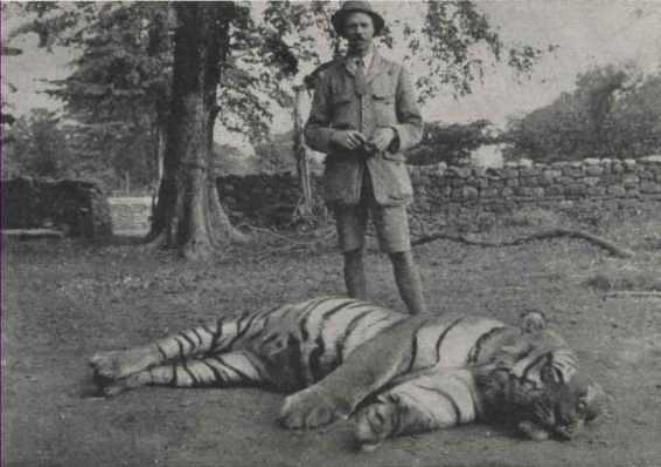India in the late 1800s and early 1900s was an interesting place, with very beautiful mountainous forest regions filled with interesting wildlife.
Tigers and leopards, which this column is about, were abundant in India right up to the early 1950s. India has suffered more through the ages under the threat of man-eating tigers and leopards than any place on earth.
The best information we have available suggests that at least 500,000 Indians and a minimum of one million people have been eaten by tigers and leopards over the entire Asian continent in the last four centuries. In the 1800s, there may have been as many as 800 man-eating tigers operating at the same time.
Tigers are not normally inclined to eat people unless diseased or injured. Leopards are simply scavengers when necessary and don’t mind eating what is available.
James Edward Corbett was born July 25, 1875, in Nainital, United Provinces, British India, in the region known as Kumaon. Jim, as he was called, grew up in the 6,000-foot high mountain country. He was a naturally gifted woodsman and hunter. He was fascinated by the wildlife around his home and learned to identify most animals and birds by their calls.
After a stint in the army and obtaining the rank of colonel, Corbett returned home and listed his profession as hunter, naturalist and writer. Interestingly, he reportedly only hunted one tiger for sport during his lifetime. Every other tiger or leopard he hunted was a man-eater, and he was asked by the province tehsildar (tax collector), who generally was more or less the highest ranking authority in the village, to kill it.
James Corbett considered himself a student of tigers and leopards rather than a hunter of the animals. He wrote books about all the wildlife in the mountain regions of India, and he was an expert speaker on wildlife and an advocate for conservation of India’s wildlife.
However, he did track and shoot a number of man-eating tigers, and at least two man-eating leopards, including the Leopard of Rudraprayag, the Leopard of Panar, the Temple Tiger, the Man Eater of Kumaon, the Talla-Des Man-Eater, the Thak Man-Eater, and the Chowgarh Tigress. Over the length of his career, Corbett killed man-eating tigers and leopards, which among them accounted for over 1,500 human victims.
In 1903, the Champawat Tigress, which had killed 200 people in Nepal, was chased out of Nepal and into the Kumaon Region of India. By 1907, it killed another 236 people in the Kumaon region of Corbett’s homeland.
In 1907, Corbett was asked by the tehsildar of Champawat to kill the murderous tigress, which had killed several people in the area. As Corbett and the tehsildar were talking, a man came running up from the village with news that a girl had just been taken by the tigress. The girl went down to the river to get water for her family when she was attacked and dragged into the jungle by the tigress. Corbett grabbed his 500 Nitro Express double rifle and ran down the slope to the river.
An explanation of the 500 Nitro express double rifle Corbett hunted with may be of interest to the reader. It has two separate barrels with two separate actions so that if one barrel becomes damaged, the other barrel and action will operate independently.
It breaks open at the breech so a panatela-sized cartridge with a 570-grain bullet can be inserted into the breech of each barrel. Each cartridge case was filled with Kynoch or cordite powder. One can expect the 570-grain bullet to exit the muzzle at 2,150 feet per second and deliver 5,850 foot-pounds of energy. It would also deliver 74.5 foot pounds of recoil, or a good old-fashioned kick into one’s shoulder.
Corbett tracked the pug marks of the cat for half a mile. The spoor then crossed over a hill and went through a brushy area. The trail then took a hard left turn and the cover grew thicker. There was a pool of water a little further ahead.
At this point, Corbett’s instincts kicked in and he got that old feeling that he was being watched from above somewhere. He backed off a bit and studied the area around the pool of water. He was sure he was close to the cat’s lair and the pool was a excellent place to drink unseen. As it was getting dark, he returned to the village because he knew he was no match for what he estimated to be a 700-pound tigress in the dark, but a plan had started to form in his mind and he thought it just might work.
Corbett normally hunted alone, but the next morning he had climbed to a grassy ledge above the pool he had seen the previous afternoon, while getting the tehsildar and the village people on top of the hill with pots and pans that they could bang together as they came down the hill above the suspected tigress lair.
At a previously agreed upon time, the village people started screaming and banging their pots and pans together as they came down the hill. Corbett, who was concealed on the high grassy ledge above the pool, waited patiently. After a few minutes Corbett saw the tigress coming down the gorge away from all the noise the villagers were making. It was going to work.
As the tigress came within 90 feet of Corbett, toward the pool, the 500 Nitro Express shattered the silence of the pool area, and a 570-grain bullet smashed into her left shoulder. She flinched and turned toward the direction from which the shot had come. In doing so, she gave Corbett a good shot at her right shoulder, and the mighty 500 sounded off again, sending another 570-grain bullet into her right shoulder, shattering the shoulder joint and continuing on into her vital area containing the heart and lungs
Now things got interesting. Corbett was out of ammunition, never thinking he would need more than two rounds. For what seemed like an eternity, Corbett and the tigress stared into each others eyes across 90 feet of jungle. Finally, the tigress turned and started to walk back up the hill and collapsed. The Man-Eater of Champawat and Kumaon was finally dead.
Col. James (Jim) Edward Corbett spent another 40 years in the Kumaon region of India as a hunter, naturalist, and writer. Then he sold his house in Kaladhungi in 1947, and retired from hunting. He and his sister moved to Nyeri, Kenya, where he continued to write and sound the alarm about the declining numbers of tigers and other wildlife. He died of a heart attack at 79 years of age, April 19, 1955, and was buried at St. Peter’s Church in Nyeri.
Smokey Merkley was raised in Idaho and has been hunting since he was 10 years old. He was a member of the faculty of Texas A&M University for 25 years. There he taught orienteering, marksmanship, self-defense, fencing, scuba diving and boxing. He was among the first DPS-certified Texas Concealed Handgun Instructors. He can be contacted at mokeydo41245@hotmail.com.



